transmission fluid FORD SUPER DUTY 2005 1.G Diesel Supplement Manual
[x] Cancel search | Manufacturer: FORD, Model Year: 2005, Model line: SUPER DUTY, Model: FORD SUPER DUTY 2005 1.GPages: 72, PDF Size: 0.52 MB
Page 2 of 72
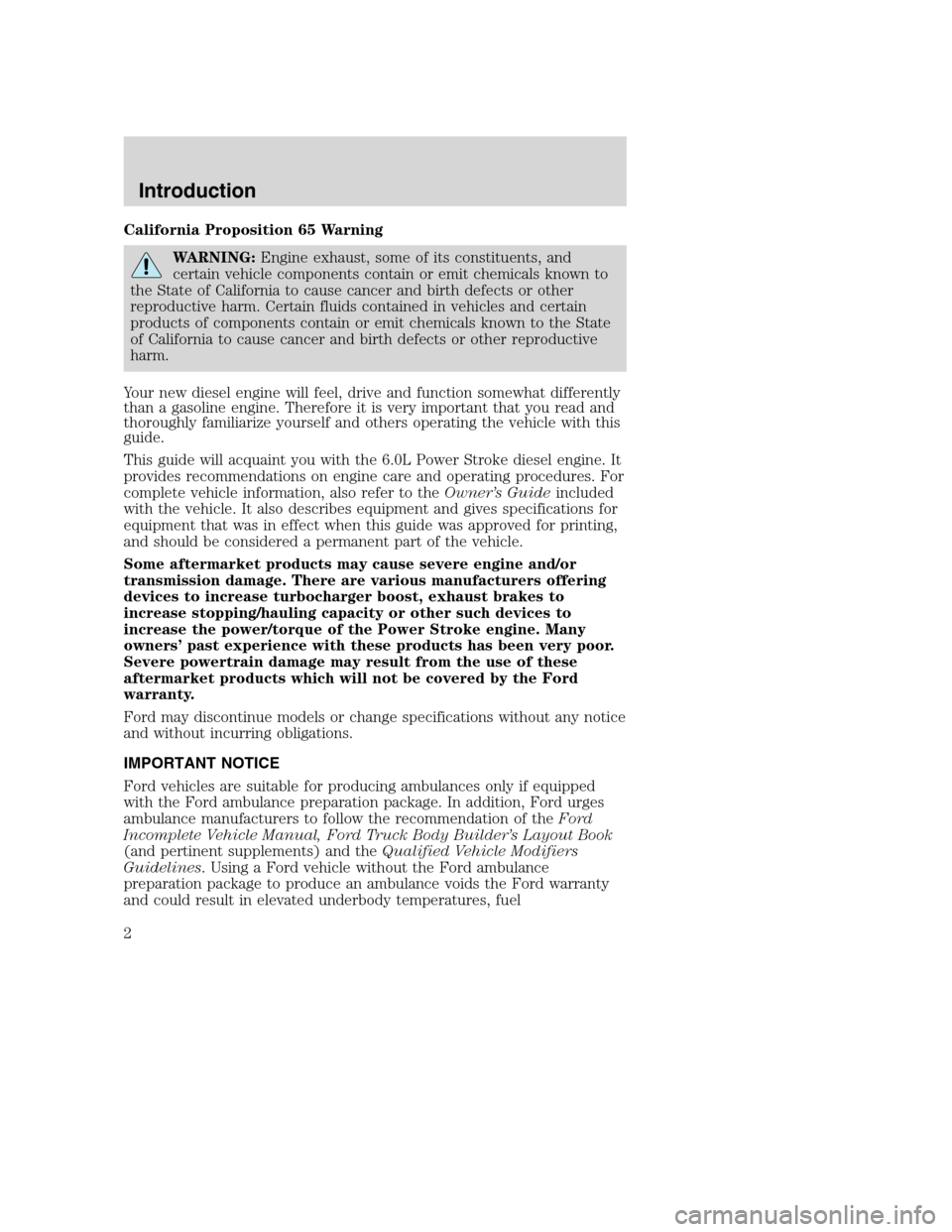
California Proposition 65 Warning
WARNING:Engine exhaust, some of its constituents, and
certain vehicle components contain or emit chemicals known to
the State of California to cause cancer and birth defects or other
reproductive harm. Certain fluids contained in vehicles and certain
products of components contain or emit chemicals known to the State
of California to cause cancer and birth defects or other reproductive
harm.
Your new diesel engine will feel, drive and function somewhat differently
than a gasoline engine. Therefore it is very important that you read and
thoroughly familiarize yourself and others operating the vehicle with this
guide.
This guide will acquaint you with the 6.0L Power Stroke diesel engine. It
provides recommendations on engine care and operating procedures. For
complete vehicle information, also refer to theOwner’s Guideincluded
with the vehicle. It also describes equipment and gives specifications for
equipment that was in effect when this guide was approved for printing,
and should be considered a permanent part of the vehicle.
Some aftermarket products may cause severe engine and/or
transmission damage. There are various manufacturers offering
devices to increase turbocharger boost, exhaust brakes to
increase stopping/hauling capacity or other such devices to
increase the power/torque of the Power Stroke engine. Many
owners’ past experience with these products has been very poor.
Severe powertrain damage may result from the use of these
aftermarket products which will not be covered by the Ford
warranty.
Ford may discontinue models or change specifications without any notice
and without incurring obligations.
IMPORTANT NOTICE
Ford vehicles are suitable for producing ambulances only if equipped
with the Ford ambulance preparation package. In addition, Ford urges
ambulance manufacturers to follow the recommendation of theFord
Incomplete Vehicle Manual, Ford Truck Body Builder’s Layout Book
(and pertinent supplements) and theQualified Vehicle Modifiers
Guidelines. Using a Ford vehicle without the Ford ambulance
preparation package to produce an ambulance voids the Ford warranty
and could result in elevated underbody temperatures, fuel
Introduction
Introduction
2
Page 12 of 72
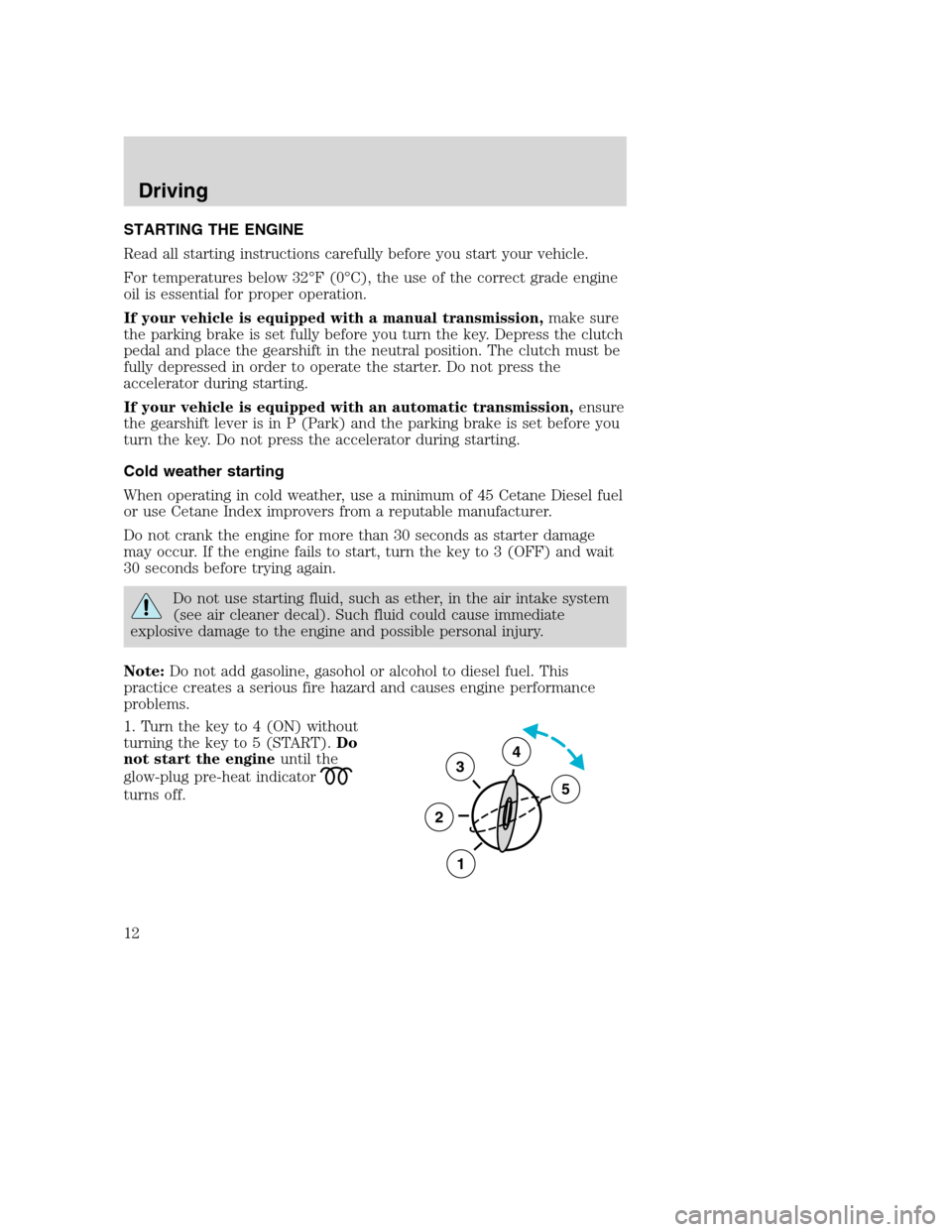
STARTING THE ENGINE
Read all starting instructions carefully before you start your vehicle.
For temperatures below 32°F(0°C), the use of the correct grade engine
oil is essential for proper operation.
If your vehicle is equipped with a manual transmission,make sure
the parking brake is set fully before you turn the key. Depress the clutch
pedal and place the gearshift in the neutral position. The clutch must be
fully depressed in order to operate the starter. Do not press the
accelerator during starting.
If your vehicle is equipped with an automatic transmission,ensure
the gearshift lever is in P (Park) and the parking brake is set before you
turn the key. Do not press the accelerator during starting.
Cold weather starting
When operating in cold weather, use a minimum of 45 Cetane Diesel fuel
or use Cetane Index improvers from a reputable manufacturer.
Do not crank the engine for more than 30 seconds as starter damage
may occur. If the engine fails to start, turn the key to 3 (OFF) and wait
30 seconds before trying again.
Do not use starting fluid, such as ether, in the air intake system
(see air cleaner decal). Such fluid could cause immediate
explosive damage to the engine and possible personal injury.
Note:Do not add gasoline, gasohol or alcohol to diesel fuel. This
practice creates a serious fire hazard and causes engine performance
problems.
1. Turn the key to 4 (ON) without
turning the key to 5 (START).Do
not start the engineuntil the
glow-plug pre-heat indicator
turns off.
3
2
1
5
4
Driving
Driving
12
Page 27 of 72
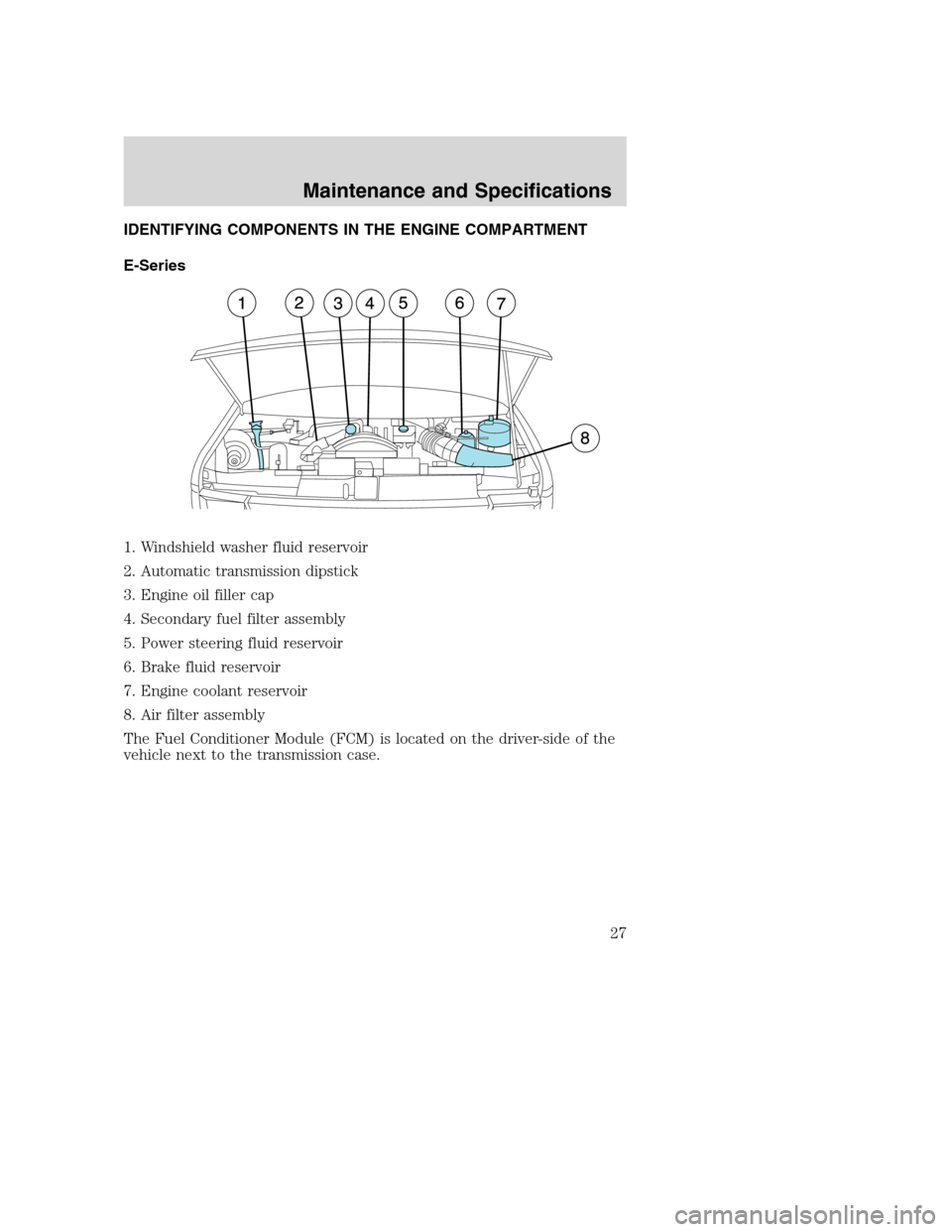
IDENTIFYING COMPONENTS IN THE ENGINE COMPARTMENT
E-Series
1. Windshield washer fluid reservoir
2. Automatic transmission dipstick
3. Engine oil filler cap
4. Secondary fuel filter assembly
5. Power steering fluid reservoir
6. Brake fluid reservoir
7. Engine coolant reservoir
8. Air filter assembly
The Fuel Conditioner Module (FCM) is located on the driver-side of the
vehicle next to the transmission case.
Maintenance and Specifications
Maintenance and Specifications
27
Page 28 of 72

F-Super Duty/Excursion
1. Automatic transmission dipstick (if equipped)
2. Engine oil fill
3. Engine oil filter
4. Engine-mounted fuel filter assembly
5. Engine coolant reservoir
6. Brake fluid reservoir
7. Clutch fluid reservoir (if equipped)
8. Underhood relay box
9. Battery (dual batteries shown)
10. Power steering fluid reservoir
11. Air filter assembly
12. Engine oil dipstick
13. Windshield washer fluid reservoir
Maintenance and Specifications
28
Page 29 of 72
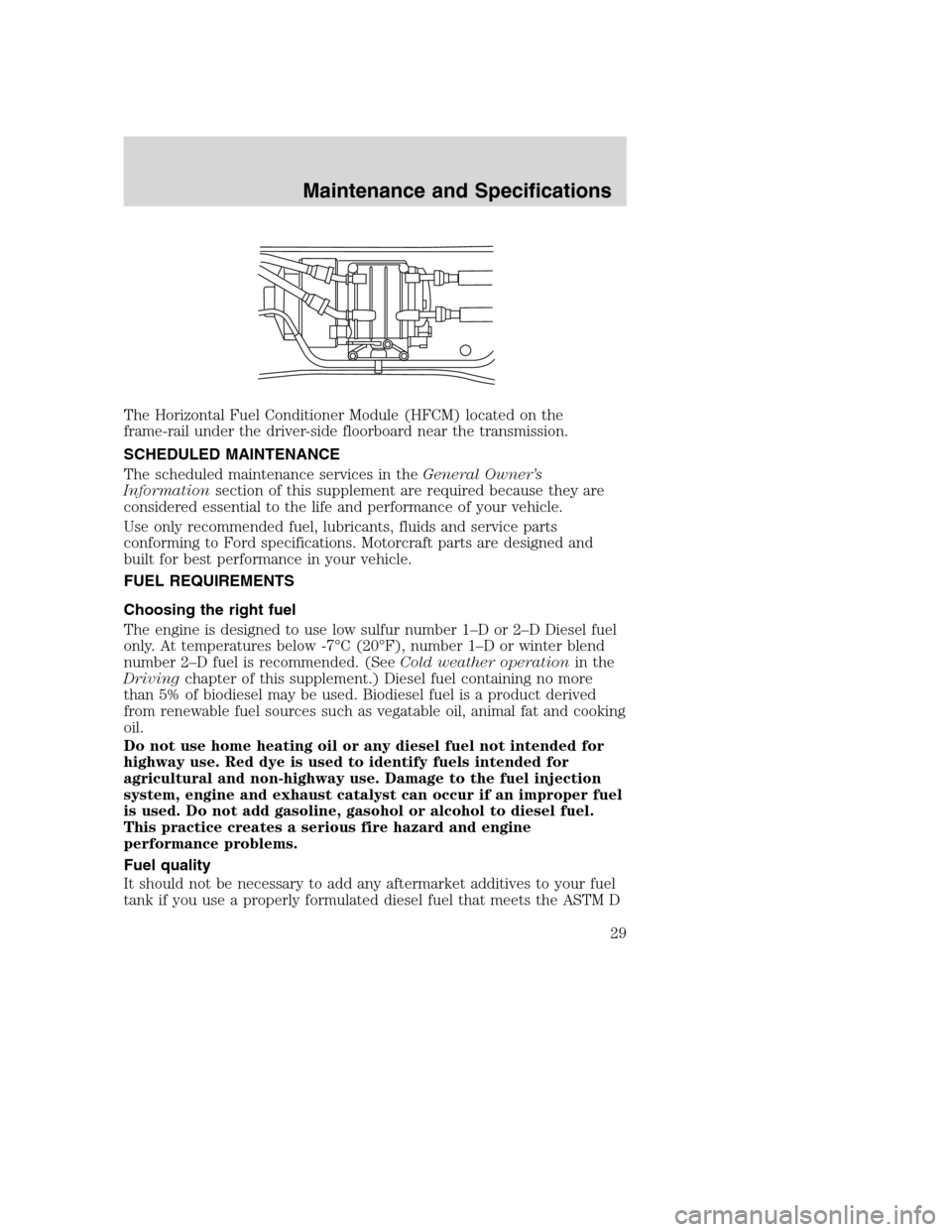
The Horizontal Fuel Conditioner Module (HFCM) located on the
frame-rail under the driver-side floorboard near the transmission.
SCHEDULED MAINTENANCE
The scheduled maintenance services in theGeneral Owner’s
Informationsection of this supplement are required because they are
considered essential to the life and performance of your vehicle.
Use only recommended fuel, lubricants, fluids and service parts
conforming to Ford specifications. Motorcraft parts are designed and
built for best performance in your vehicle.
FUEL REQUIREMENTS
Choosing the right fuel
The engine is designed to use low sulfur number 1–Dor2–D Diesel fuel
only. At temperatures below -7°C (20°F), number 1–D or winter blend
number 2–D fuel is recommended. (SeeCold weather operationin the
Drivingchapter of this supplement.) Diesel fuel containing no more
than 5% of biodiesel may be used. Biodiesel fuel is a product derived
from renewable fuel sources such as vegatable oil, animal fat and cooking
oil.
Do not use home heating oil or any diesel fuel not intended for
highway use. Red dye is used to identify fuels intended for
agricultural and non-highway use. Damage to the fuel injection
system, engine and exhaust catalyst can occur if an improper fuel
is used. Do not add gasoline, gasohol or alcohol to diesel fuel.
This practice creates a serious fire hazard and engine
performance problems.
Fuel quality
It should not be necessary to add any aftermarket additives to your fuel
tank if you use a properly formulated diesel fuel that meets the ASTM D
Maintenance and Specifications
29
Page 53 of 72

•Check power steering fluid level
•Check washer spray, wiper operation and clean all wiper blades
(replace as necessary)
•Check parking brake for proper operation
•Check and lubricate all hinges, latches and outside locks
•Check and lubricate door rubber weatherstrips
•Check and clean body and door drain holes
•Check safety warning lamps (brake, ABS, air bag, safety belt) for
operation
•Check cooling system fluid level and coolant strength
•Check battery connections and clean if necessary
•Check clutch fluid level, if equipped
Multi-point Inspection
In order to keep your vehicle running right, it is important that you have
the systems on your vehicle checked regularly. This can help identify any
potential issue before there are any problems. Ford Motor Company
suggests the following multi-point inspection to be performed at every
scheduled maintenance as the way to ensure your vehicle keeps running
right.
Multi-point inspection - Recommended at every visit
•Check and top up fluid levels: brake, coolant recovery reservoir,
manual and automatic transmission, power steering and window
washer.
•Inspect tires for wear and check air pressure, including spare.
•Check exhaust system for leaks, damage, loose parts and foreign
materials.
•Check battery performance.
•Check operation of horn, exterior lamps, turn signals and hazard
warning lights.
•Check radiator, coolers and heater and air conditioning hoses.
•Inspect windshield washer spray and wiper operation.
•Check windshield for cracks, chips and pitting.
•Inspect for oil and fluid leaks.
•Inspect air cleaner filter.
General Owner’s Information
53
Page 55 of 72

•Inspect exhaust system and heat shields
•Check wheels for end play and noise
•Inspect and lubricate 4x4 front axle u-joints
Date:
Odometer reading:
R.O.#Dealer’s Stamp:
22,500 miles (36,000 km)
•Change engine oil and replace oil filter
•Perform multi-point inspection (recommended)
•Inspect tires for wear. Rotation recommended for optimal tire life.
•Inspect air filter restriction gauge, replace filter as required
Date:
Odometer reading:
R.O.#Dealer’s Stamp:
30,000 miles (48,000 km)
•Change engine oil and replace oil filter
•Replace engine- and frame-mounted fuel filters
•Change automatic transmission fluid and external filter element
•Perform multi-point inspection (recommended)
•Inspect tires for wear and rotate
•Inspect air filter restriction gauge, replace filter as required
•Inspect and lubricate steering linkage, ball joints, suspension,
driveshaft and u-joints.
•Inspect engine cooling system and hoses
•Inspect brake pads, shoes, rotors, drums, brake lines and hoses and
parking brake system.
•Inspect exhaust system and heat shields
•Check wheels for end play and noise
General Owner’s Information
55
Page 57 of 72
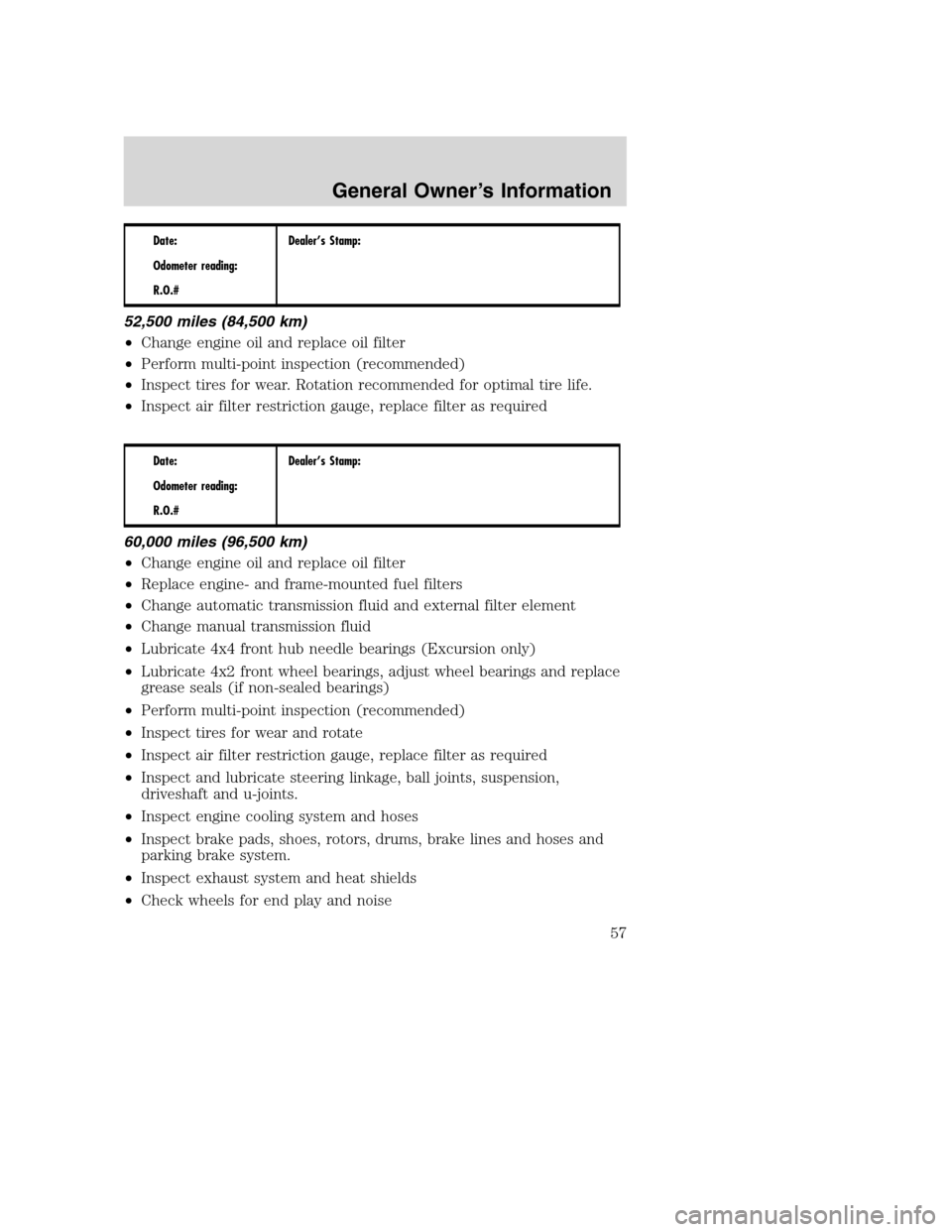
Date:
Odometer reading:
R.O.#Dealer’s Stamp:
52,500 miles (84,500 km)
•Change engine oil and replace oil filter
•Perform multi-point inspection (recommended)
•Inspect tires for wear. Rotation recommended for optimal tire life.
•Inspect air filter restriction gauge, replace filter as required
Date:
Odometer reading:
R.O.#Dealer’s Stamp:
60,000 miles (96,500 km)
•Change engine oil and replace oil filter
•Replace engine- and frame-mounted fuel filters
•Change automatic transmission fluid and external filter element
•Change manual transmission fluid
•Lubricate 4x4 front hub needle bearings (Excursion only)
•Lubricate 4x2 front wheel bearings, adjust wheel bearings and replace
grease seals (if non-sealed bearings)
•Perform multi-point inspection (recommended)
•Inspect tires for wear and rotate
•Inspect air filter restriction gauge, replace filter as required
•Inspect and lubricate steering linkage, ball joints, suspension,
driveshaft and u-joints.
•Inspect engine cooling system and hoses
•Inspect brake pads, shoes, rotors, drums, brake lines and hoses and
parking brake system.
•Inspect exhaust system and heat shields
•Check wheels for end play and noise
General Owner’s Information
57
Page 59 of 72
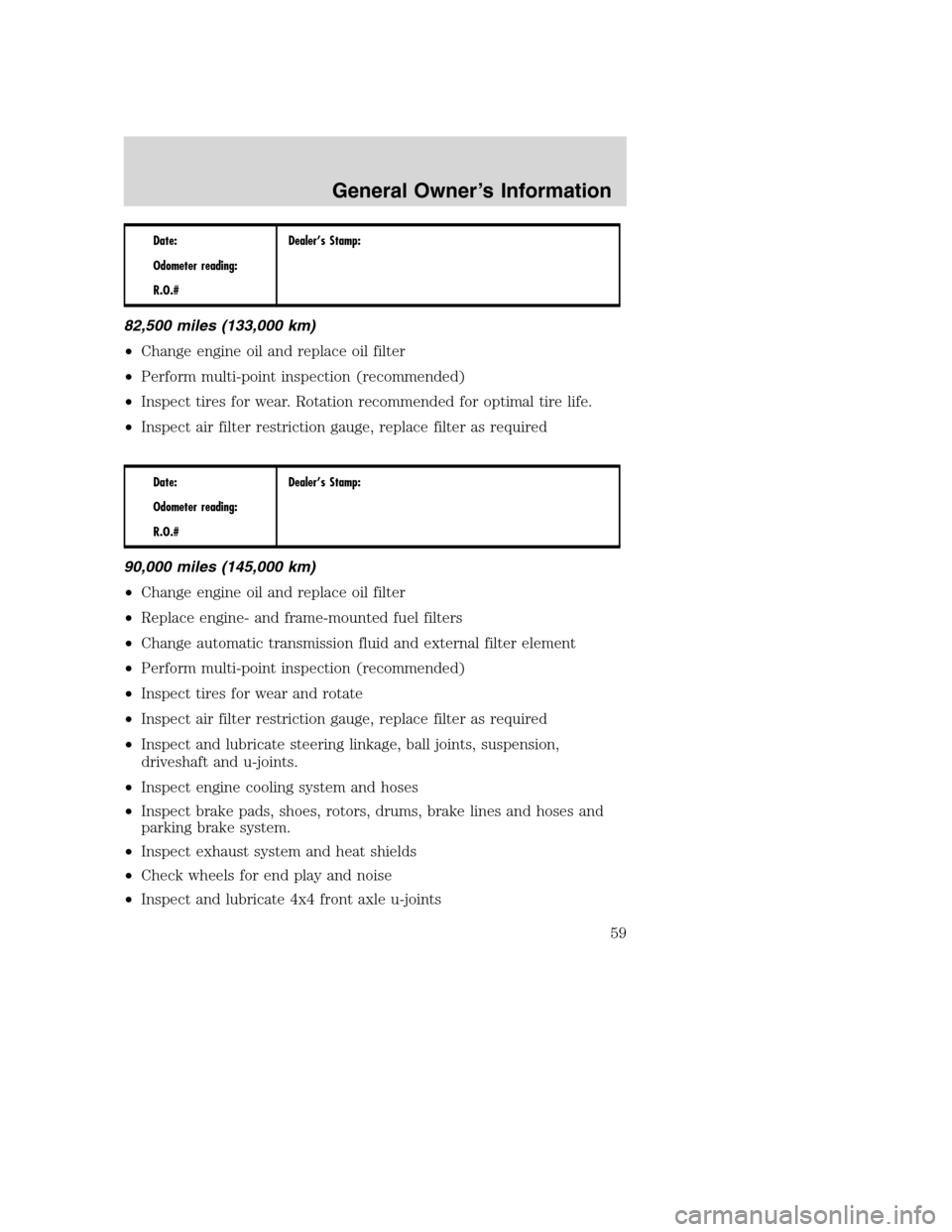
Date:
Odometer reading:
R.O.#Dealer’s Stamp:
82,500 miles (133,000 km)
•Change engine oil and replace oil filter
•Perform multi-point inspection (recommended)
•Inspect tires for wear. Rotation recommended for optimal tire life.
•Inspect air filter restriction gauge, replace filter as required
Date:
Odometer reading:
R.O.#Dealer’s Stamp:
90,000 miles (145,000 km)
•Change engine oil and replace oil filter
•Replace engine- and frame-mounted fuel filters
•Change automatic transmission fluid and external filter element
•Perform multi-point inspection (recommended)
•Inspect tires for wear and rotate
•Inspect air filter restriction gauge, replace filter as required
•Inspect and lubricate steering linkage, ball joints, suspension,
driveshaft and u-joints.
•Inspect engine cooling system and hoses
•Inspect brake pads, shoes, rotors, drums, brake lines and hoses and
parking brake system.
•Inspect exhaust system and heat shields
•Check wheels for end play and noise
•Inspect and lubricate 4x4 front axle u-joints
General Owner’s Information
59
Page 61 of 72
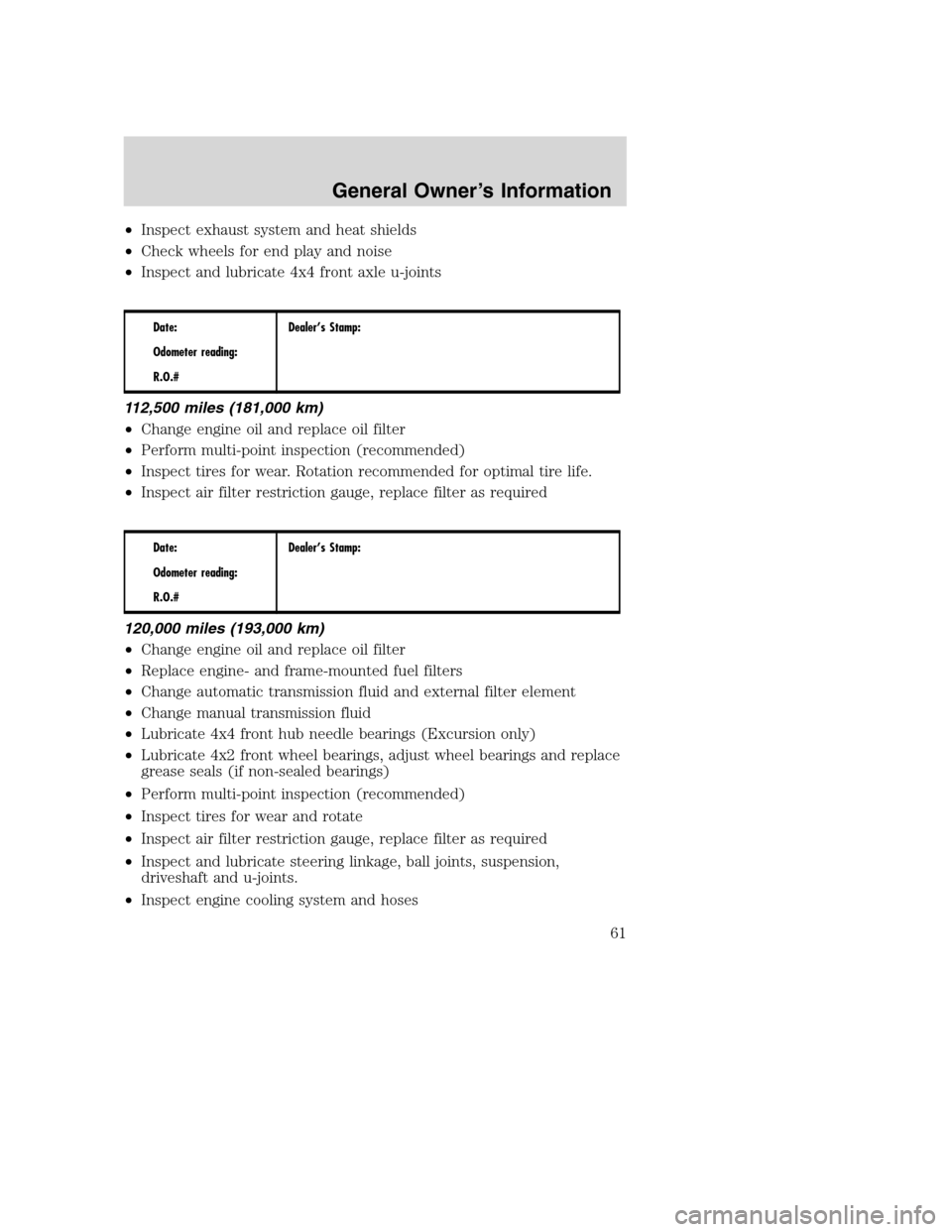
•Inspect exhaust system and heat shields
•Check wheels for end play and noise
•Inspect and lubricate 4x4 front axle u-joints
Date:
Odometer reading:
R.O.#Dealer’s Stamp:
112,500 miles (181,000 km)
•Change engine oil and replace oil filter
•Perform multi-point inspection (recommended)
•Inspect tires for wear. Rotation recommended for optimal tire life.
•Inspect air filter restriction gauge, replace filter as required
Date:
Odometer reading:
R.O.#Dealer’s Stamp:
120,000 miles (193,000 km)
•Change engine oil and replace oil filter
•Replace engine- and frame-mounted fuel filters
•Change automatic transmission fluid and external filter element
•Change manual transmission fluid
•Lubricate 4x4 front hub needle bearings (Excursion only)
•Lubricate 4x2 front wheel bearings, adjust wheel bearings and replace
grease seals (if non-sealed bearings)
•Perform multi-point inspection (recommended)
•Inspect tires for wear and rotate
•Inspect air filter restriction gauge, replace filter as required
•Inspect and lubricate steering linkage, ball joints, suspension,
driveshaft and u-joints.
•Inspect engine cooling system and hoses
General Owner’s Information
61